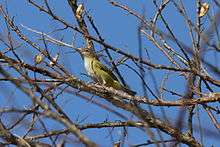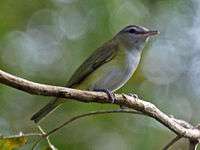Yellow-green vireo
| Yellow-green vireo | |
|---|---|
 | |
| In Panama | |
| Scientific classification | |
| Kingdom: | Animalia |
| Phylum: | Chordata |
| Class: | Aves |
| Order: | Passeriformes |
| Family: | Vireonidae |
| Genus: | Vireo |
| Species: | V. flavoviridis |
| Binomial name | |
| Vireo flavoviridis (Cassin, 1851) | |
| Synonyms | |
|
Vireo olivaceus flavoviridis | |
The yellow-green vireo (Vireo flavoviridis) is a small passerine bird. It breeds from southern Texas (occasionally the Rio Grande Valley) in the United States and the western and eastern mountain ranges of northern Mexico (the Sierra Madre Occidental and Sierra Madre Oriental—also the Cordillera Neovolcanica) south to central Panama. It is migratory, wintering in the northern and eastern Andes and the western Amazon Basin.
The adult yellow-green vireo is 14–14.7 cm in length and weighs 18.5 g. It has olive-green upperparts and a dusky-edged gray crown. There is a dark line from the bill to the red-brown eyes, and a white supercilium. The underparts are white with yellow breast sides and flanks. Young birds are duller with brown eyes, a brown tint to the back, and less yellow on the underparts. The adult yellow-green vireo differs from the red-eyed vireo in its much yellower underparts, lack of a black border to the duller gray crown, yellower upperparts and different eye color.
Some individuals are difficult to separate, even in the hand, from the similar red-eyed vireo, with which it is sometimes considered conspecific. Its exact status as a passage bird in countries such as Venezuela is therefore uncertain.
The yellow-green vireo has a nasal nyaaah call, and the song is a repetitive veree veer viree, fee’er vireo viree, shorter and faster than that of the red-eyed vireo. This species rarely sings on its wintering grounds.
This vireo occurs in the canopy and middle levels of light woodland, the edges of forest, and gardens at altitudes from sea level to 1500 m. The 6.5-cm-wide cup nest is built by the female from a wide range of plant materials, and attached to a stout twig normally 1.5–3.5 m above the ground in a tree, but occasionally up to 12 m high. The normal clutch is two or three brown-marked white eggs laid from March to June and incubated by the female alone, although the male helps to feed the chicks. The breeding birds return to Central America from early February to March, and most depart southwards by mid-October.
Yellow-green vireos feed on insects gleaned from tree foliage, favoring caterpillars and beetles. They also eat small fruits, including mistletoe berries, and, in winter quarters, those of Cymbopetalum mayanum (Annonaceae) and gumbo-limbo (Bursera simaruba).[2]
Gallery
 Panama
Panama
References
- ↑ BirdLife International (2012). "Vireo flavoviridis". IUCN Red List of Threatened Species. Version 2013.2. International Union for Conservation of Nature. Retrieved 26 November 2013.
- ↑ Foster (2007)
- Hilty, Steven L. (2003): Birds of Venezuela. Christopher Helm, London. ISBN 0-7136-6418-5
- Stiles, F. Gary & Skutch, Alexander Frank (1989): A guide to the birds of Costa Rica. Comistock, Ithaca. ISBN 0-8014-9600-4
External links
- Photo; Article CBRC Rare Bird Photos, California Bird Records Committee
- Photo-2 CBRC Rare Bird Photos Article
- Yellow-green Vireo photo gallery VIREO-Visual Resources for Ornithology Photo-High Res--(Close-up)
- Yellow-green Vireo photo; Article "Avifauna of Eco-Region, Sierra Nevada de Santa Marta, Colombia"
